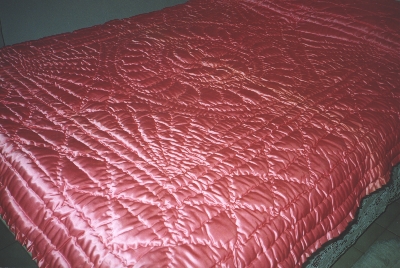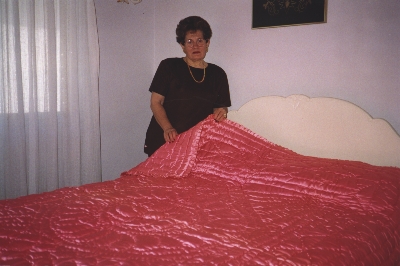Quilt No.919MK - Maria Kirke

2000 x 1770 mm
The quilt was made in Sydney in the early 1950s by a quilt maker whose name is unknown. He was recommended to Maria's parents by her aunt Katina Kiossoglou.The quiltmaker also made a quilt for Maria's sister and one for her aunt Nina Conomos.
"Maria's Paploma
Maria's 'paploma' (quilt), still in pristine condition, was made in Sydney in the early 1950s, by the same quiltmaker who made a paploma for her aunt, Nina Conomos. Another aunt, Katina Kiossoglou introduced Maria's parents, Despina and Lucas Kirke to this quiltmaker, who probably came from the Greek island of Kastellorizo, as they did. Maria's sister, Helen Lampros also scored a traditional paploma for her' prika' (dowry or trousseau) from her parents' Sydney trip. No prika was complete without a paploma, a tradition which is especially strong with the women from Kastellorizo.
Despina, Maria's mother was seventeen when she came to Australia to join her brother, Agapitos. Life in Kastellorizo had become extremely difficult from years of Italian occupation, and a large proportion of the island's population eventually migrated to Australia. In 1939 in Innisfail, she married Lucas whose parents, Nick and Helen Karakyriakos were part of the early wave of Greek migrants who were involved with the sugar industry in north Queensland. Lucas had worked with his father on their canefarm at Silkwood, south of Innisfail. Despina and Lucas went on to have four children: Helen, Maria, Nicholas and Rosalie.
As with so many Greek Australian women of the time, Maria's business skills developed from a very young age when she helped her father with his snack- bar and other ventures. Her many interesting years in retail and management included twelve years of living and working in Pireaus, the busy port of Athens. Maria, now retired from her active, travelling life, is at home caring for her mother, Despina."
[Written by Lula Saunders, adapted from interview 6/9/00 for the National Quilt Register]

Related Quilts:
2000 x 1820mm
1677 x 1144mm
1520 x 990 mm
2040 x 1750mm






